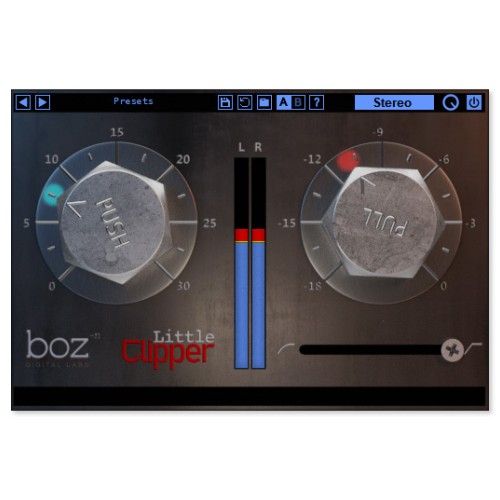
Hard/Soft Clipping Plugin - Little Clipper 2
Just like the constellations they’re named for, Little Clipper is a smaller, but no less capable version of the Big Clipper. Both provide a path to the sonic benefits of clipping combined with limiting, but the Little Clipper offers a simpler and more direct route in applications where you don’t require the shaping, blending, and frequency sensitivity controls of the Big Clipper. Little Clipper combines a variable clipping algorithm with limiting in three simple controls. The two main knobs, Push (clipping) and Pull (limiting), control the intensity of clipping and amount of limiting. A slider beneath the Pull knob lets you control the shape of clipping from soft to hard, depending on how subtle or aggressive you want the clipping to be. Between the knobs are meters that show incoming level and threshold, above which clipping occurs. Little Clipper has a toolbar that provides presets, A/B banks for comparison, a blend knob, bypass, and most significantly, a selector that lets you choose between stereo, mid + side, mid only, and side only processing. Once you experience how easy it is to balance instruments and vocals in a mix with Little Clipper, you’ll feel like you’re cheating.
Little Clipper - Just the Facts:
- Hard/Soft Clipping
- Intuitive Input Gain and Ceiling controls
- Mix knob for blending your dry sound back in
Cracking the Code
Wait, what? Sonic benefits of clipping? Aren’t we supposed to avoid clipping?
We’ve all been there: You’ve got your mix sounding the way you want; drums are punchy and prominent, you snare has power and punch, but then you look at the track overload meters in the red and think you need to pull levels down to prevent all the clipping (which you didn’t hear). So you start pulling down the faders and all of sudden, your snare becomes a snore, your entire mix, once awake and exciting, is now a snooze fest. You’ve just experienced the benefits of clipping.
Clipping is the analog of overdriven tube distortion and tape saturation, both meant to be avoided, but engineers with golden ears discovered that distortion, albeit counter-intuitively, provided a means of making instruments and vocals stand out in a mix with clarity. The distortion itself wasn’t heard unless you pushed it too hard. Currently, there is no shortage of analog distortion generators in both hardware and modeling software.
As being said, clipping is the analogous form of distortion in digital systems. Analog distortion mostly took the form of gentle clipping and saturation, which softened transients and added rich harmonics. Digital clipping does the same thing, but with a narrower window between pleasing and unusable. It’s easy to overdo digital clipping, but when judiciously applied, it can make mixing easier. Elements in a mix fall into place more easily, while dynamics are more controlled and transparent. This is due to softened transients preventing compressors from punching holes in your mix (everything beneath a transient gets pushed down by the compressor). Digital clipping can bring cohesion or glue to mix, and when combined with limiting, can help you emerge victorious from the loudness wars - victory is yours.
Mac:
- macOS 10.5 or higher
Windows:
- Windows 8 or higher
Required Registration:
Boz Digital Labs products require you to register with the manufacturer at www.bozdigitallabs.com to activate your license.
This product requires an activation!
An internet connection is required to authorize / activate the product.



